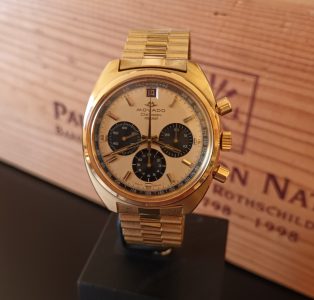I swear to God that I cannot quite recall how I came across this watch. I think I was investigating something else on Chrono 24, but the dealer had other pieces on the site so I may have just gravitated to these. Anyway, I was frankly blown away by the Panda dial and the gold case/ bracelet (plated). I had some knowledge of this attractive chronograph, so knew that it contained within a version of Zenith’s earliest El Primero movement. As such it was worthy of more scrutiny!
In order to make any enquiry, I first had to set up an account with CH24. This was reasonably straightforward, and once done was able to email the vendor. I had already established that he was in London, so that at least would making buying easier and cheaper! Anyway, I posed a few questions. The watch was apparently in unworn condition, but had no accompaniments. I also checked the bracelet size which seemed satisfactory. The price was a little over £2,800, so whilst not outrageous, I felt it to be a little on the high side so decided to haggle a bit. One other reason for doing so was that; as I had never bought via CH24, I felt that if the watch came and was a bit deficient in some way, any discount may compensate. Yes, I am aware that you have to receive the goods before money is passed over, and there is some kind of 7 day window to raise any issues, but frankly I did not want to get into all that! Anyway, after a bit of haggling we ended up at some £2,530 which I thought fair. I then transmitted the funds via my credit card to CH 24’s escrow account.
A couple of days later I got the watch and it was, more or less, in the condition stated. However, my negotiations proved sensible. Why? Well, despite six elements being noted as “mint condition”, that was not quite the case. Firstly, two links near the case were very slightly deformed so would not bend quite as easily as the other side. Secondly, the lug tops all had a curving 1 mm line of a different finish in the middle of them. After scrutiny with a loupe, it is in fact a slightly more polished band than the rest of the brushing, and it certainly was not from the factory (or due to age discolouration, as the vendor subsequently suggested), but more likely from some shaky aftermarket polishing. I sorted out the links quite easily, and as the lug marks are not very obvious – plus in other respects the watch is complete and very good indeed, I was willing to accept. In fact, should I decide to have the case polished to sort out the lugs, it will cost £200 at a good source. I would just say that it is possible that the vendor simply did not notice these fairly minute imperfections, but, as a pedantic collector, I did!
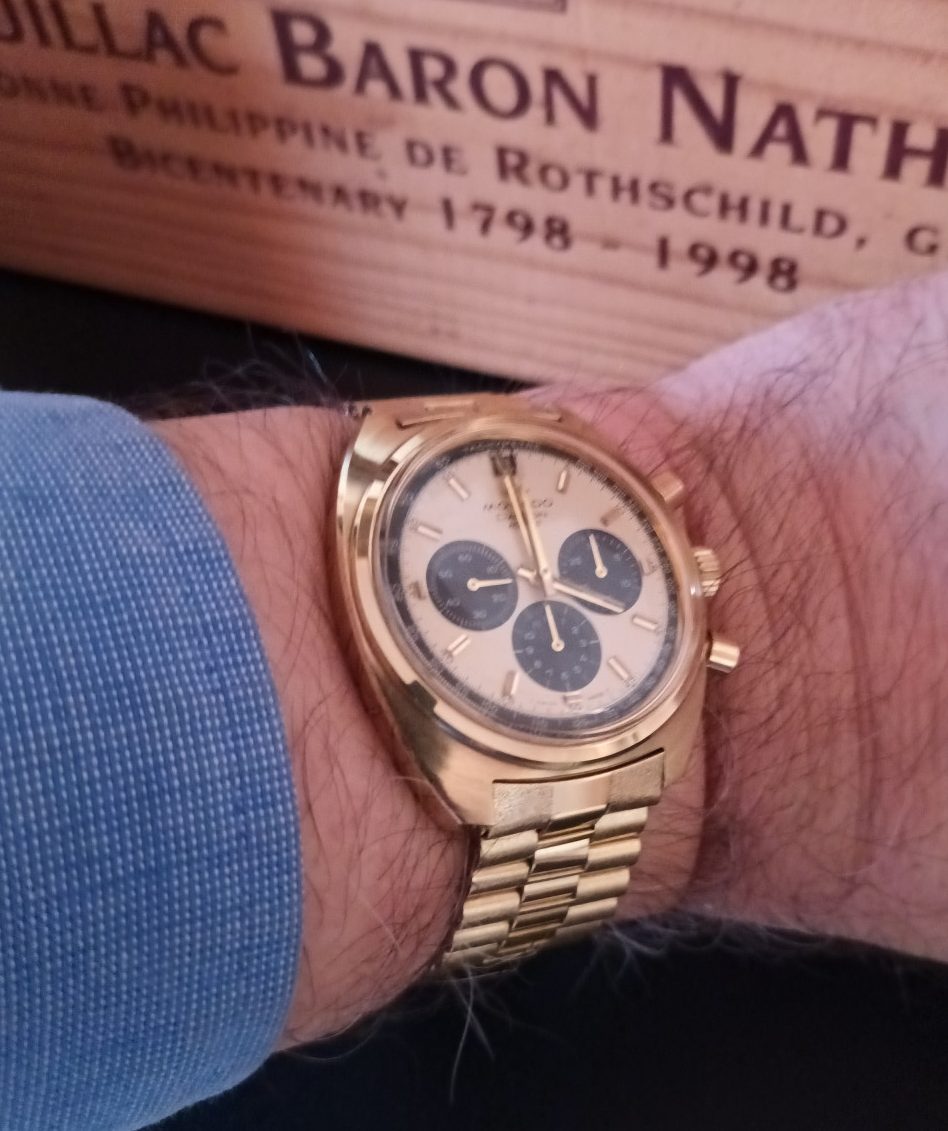
Before talking about the watch more, a little on Movado. Well, the company was started in 1881 by a young entrepreneur – the delightfully named Achillies Ditesheim! They were based in – surprise surprise, Chaux de Fonds. Initially they simply sourced components from third parties and cased them up into pocket watches. From around 1905 things were going pretty well, and the company had some 80 employees. It was at this time that in fact the Movado name incepted, and means, in Esperanto, “Always In Motion”! During the 1st WW they supplied watches on a large scale, having pioneered the use of electrical watch machinery which reduced production costs. In the mid-twenties they really started to innovate, and one success was the Polyplan wristwatch which had an ergonomically designed curved case and movement. In 1928, they began producing their Ermento range of travelling watch/clocks. These were small and square and were housed in a rectangular case – a two-sided sliding box if you will. A year or so later, the sliding motion of the box opening and closing actually powered the watch! Some of these watches were in precious metals and also double-signed – with the likes of Tiffany, Hermes and Cartier, so were highly regarded. Towards the end of the 30’s Movado designed two important chronograph movements, calibers M90 (two registers) and M95 (three registers). In addition to chronographs, triple calendar watches and ones with lunar phases emerged plus, the avant garde “Museum Watch. This minimalist watch (well, mainly the dial) was designed by US industrial designer Nathan George Horwitt in 1946, and featured a plain black dial with no numbers of indexes. There were just the two hands and a gold disc (representing the sun) at 12 o’clock. This was Bauhaus influenced and was accepted by New York’s Museum of Modern Art in 1947. By 1948 Movado started to produce this watch, and by then overall production was in the tens of thousands with some 300 persons being employed.
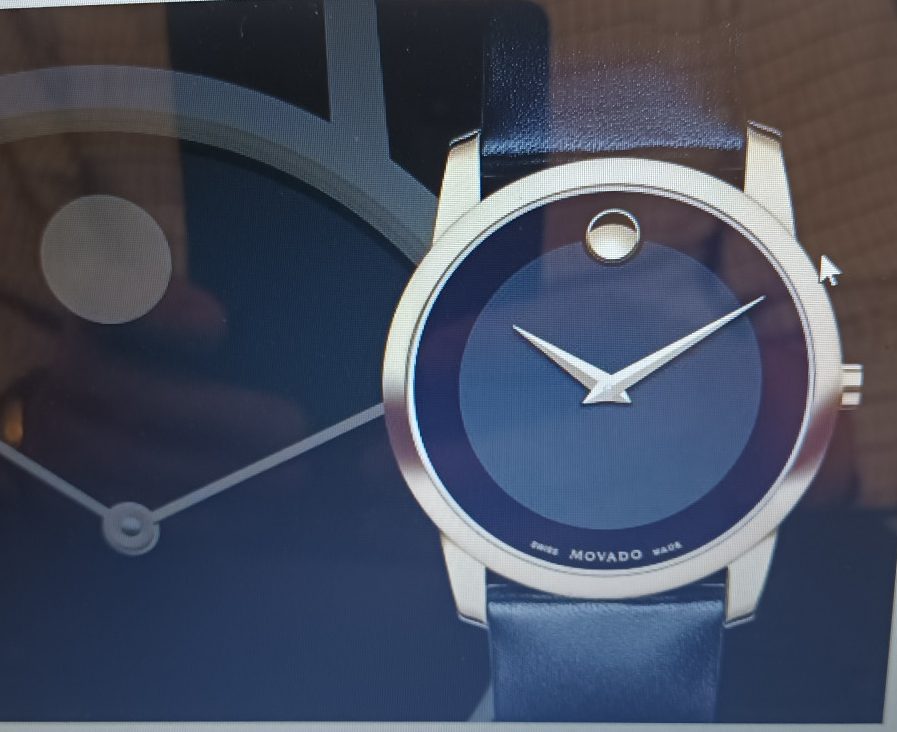
Getting more up to date, in the early 60’s the Sub Sea range was launched and these were sports and dive orientated watches – some being just time/date but also chronographs, and in the main the movements were in-house. Towards the mid 60’s Movado was now within a holding group MZM (Mondia Zenith Movado). There were good reasons for this: Firstly, Movado had some great chronograph movements that when they combined with Zenith’s expertise too, resulted in the El Primero 36,000 vph unit. Secondly, for strategic reasons. Zenith needed to market the new movement as widely as possible, however, they had a problem in the United States as that market was not open to them due to the fact that a TV manufacturer there was called Zenith Electrics. Movado had no such issues and was already well-established in the US, so the plan was that Movado would sell some of their existing models there, but powered by the El Primero movement. There were a couple of minor alterations to the movement. Firstly, for the US market the movement had just Movado noted, plus, the number of jewels had to be reduced from 31 to 17 as, for some bizarre reason, there was a tax hike at this point (which still exists today! Ed). Secondly, the date window would be at 12 o’clock (rather than the El Primero standard of between 4 and 5 o’clock) to further enhance Movado (rather than Zenith) credentials. By all accounts this plan worked out pretty well.
Movado became a separate entity again in the mid 70’s, but by the early 80’s fell into financial trouble and was bought by Cuban exile Gedalo Grinberg and his huge North American Watch Group. That is as far as we will go as today, alas, Movado only now offer “affordable” watches, obtainable in most shopping centers. Other watch brands in the stable are mainly fashion types. They do still produce the Museum Watch (Classic) and this is of course an interesting piece (although now pretty cheap and quartz powered), along with a stainless steel Datron chronograph – but not with the EP movement.
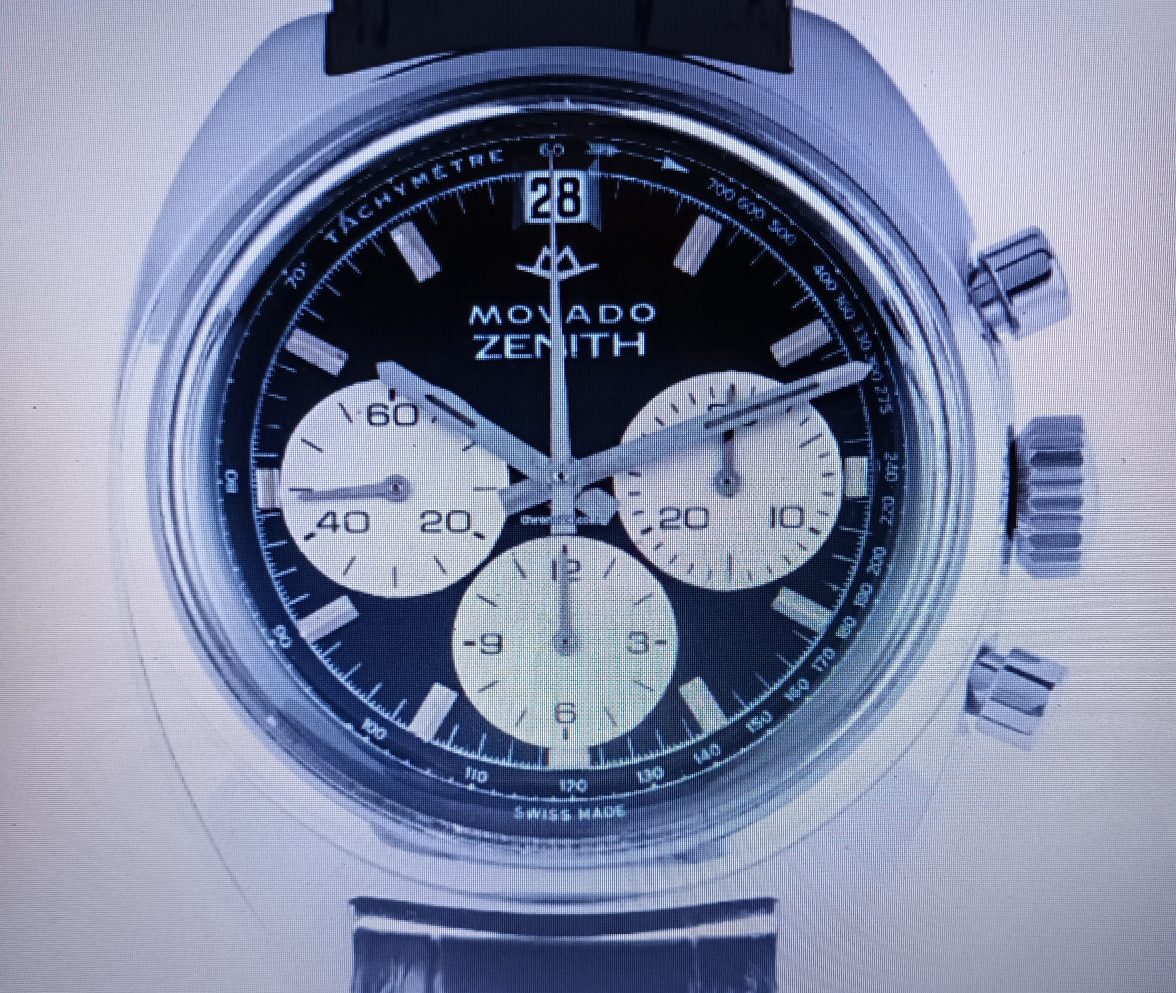
Now to the Datron Sub Sea HS 360 itself. Well, it was launched in 1969 in stainless steel, with gold variants from 1970. Some very early production pieces say just Movado Zenith on the dial. Then the watch was named Datachron, and this appears on watches probably made in the first year of production. However, for some reason the name changed again to Datron, and this stayed for the balance of production – possibly for about four years or so, as this is when Zenith ceased producing the El Primero movement in order to focus on quartz production. In fact, and digressing slightly, all the tooling and components were supposed to have been destroyed, but thankfully a loyal worker disobeyed the instructions and secretly hid them all away. I say thankfully, as when Zenith was looking increasingly in financial straights in the late 70’s/early 80’s, they decided to resume mechanical production as there was by now a trend back to this. Anyway, hey presto, the worker “found” the lost equipment so El Primero production resumed and in fact variants went on in the 80’s to power other brand’s watches such as Ebel’s 1911 and the Rolex Daytona. The subsequent revenue basically saved Zenith, and the El Primero movement is probably the most famous and important of it’s type. It is still produced today, with even greater timing capability and accuracy.
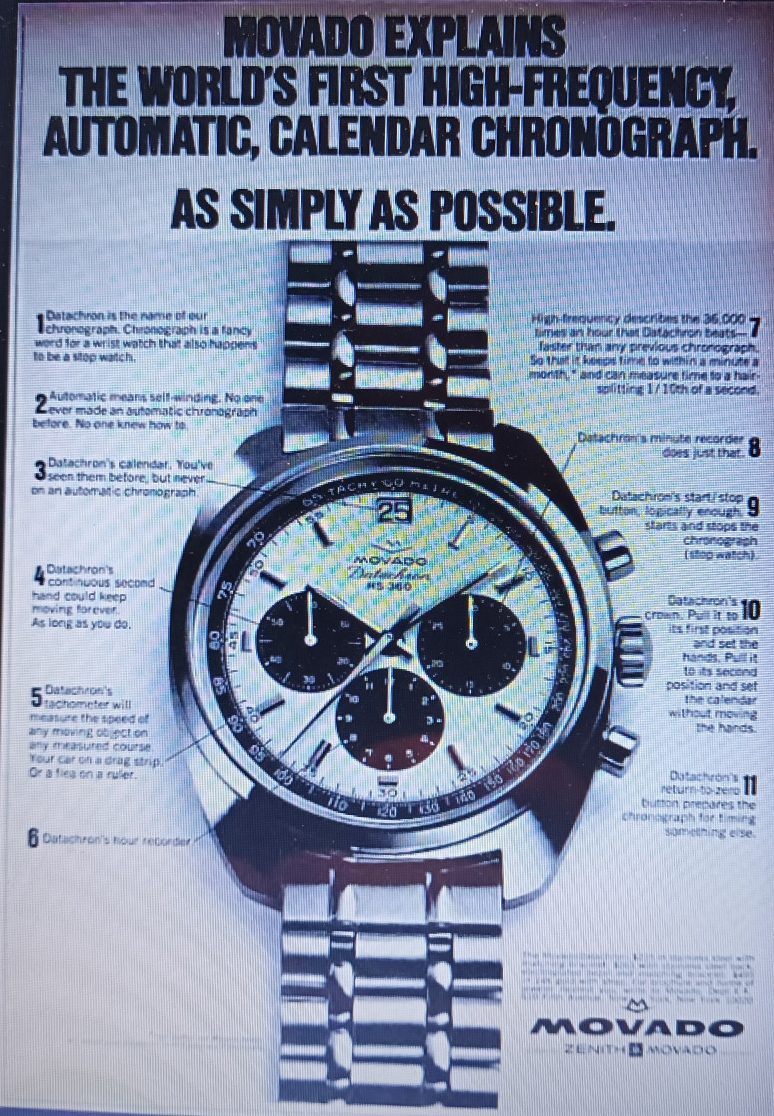
The Datron Sub Sea chronograph did not use a Zenith designed case, but a slightly toned down tonneau type from one of Movado’s old collaborators Taubert. This was 38 mm x 13 mm, with an 18 mm lug width. Cases were made in either stainless steel, 20 micron gold plated (as in this case), or 14/18 ct gold – all gold versions by the way are quite rare. All had plain bezels with a domed plexiglass and are on a bracelet, which, here at least, has small links with the central ones polished and the outboard ones having a frosted pattern. The flip clasp is a little flimsy but works well enough and this has the Movado M on it. Another useful feature here is that because the bracelet has no easy adjustable links, the clasp can stretch a little (some 5 mm or so) on a spring. If further adjustment is required then links would have to be removed by pin extraction, so for most folks a trip to the jeweller. The bracelet is pretty well integrated into the case. The case sides are polished and this extends onto the chamfered edge, with the lug tops lightly brushed. The case back is solid. There is no indication of a waterproofing level, but may probably be 30 or 50m. To be noted at this point, that running in parallel was a very similar watch called the Datron (or Datachron) Super Sub Sea HS 360. This had a similar but larger case (at 42mm) with crown guards. In addition it sported a numbered and rotatable bezel. Waterproofing was to a depth of 100m.
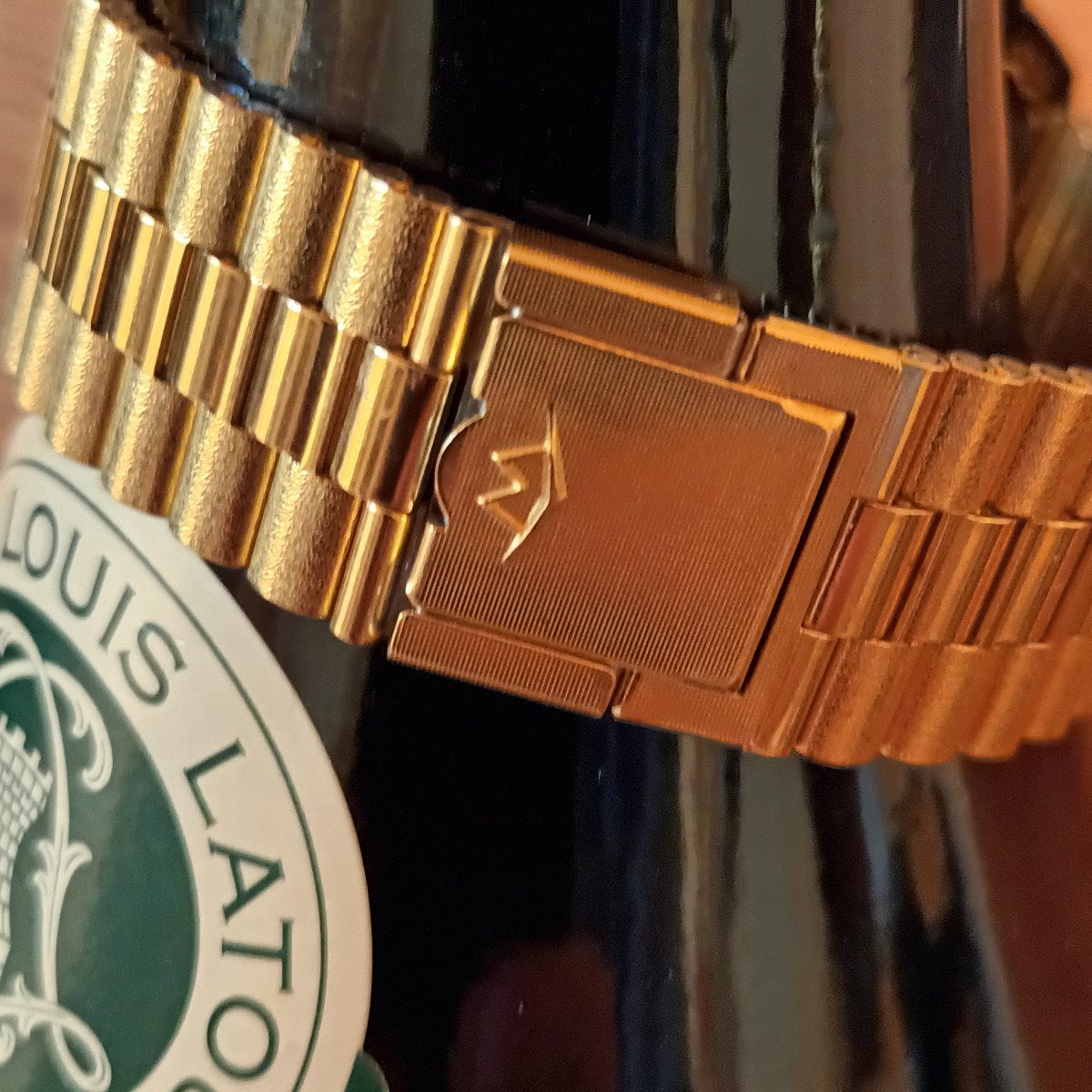
The dials were either; Panda (with either white or champagne backing) or reverse Panda on black. There was also a rare blue version. Here, the dial is champagne – but also borders on a pale cream, which is very attractive and also rarer. Due to the El Primero movement, there are of course three registers with; running seconds on the left, minutes on the right and hours at the bottom. As already noted, the date is at 12 o’clock and not the more usual EP trait at 4.30. There is a black tachymeter track outboard. The hands are, really, straight batons, as are the indexes. All have lume (Tritium) content.
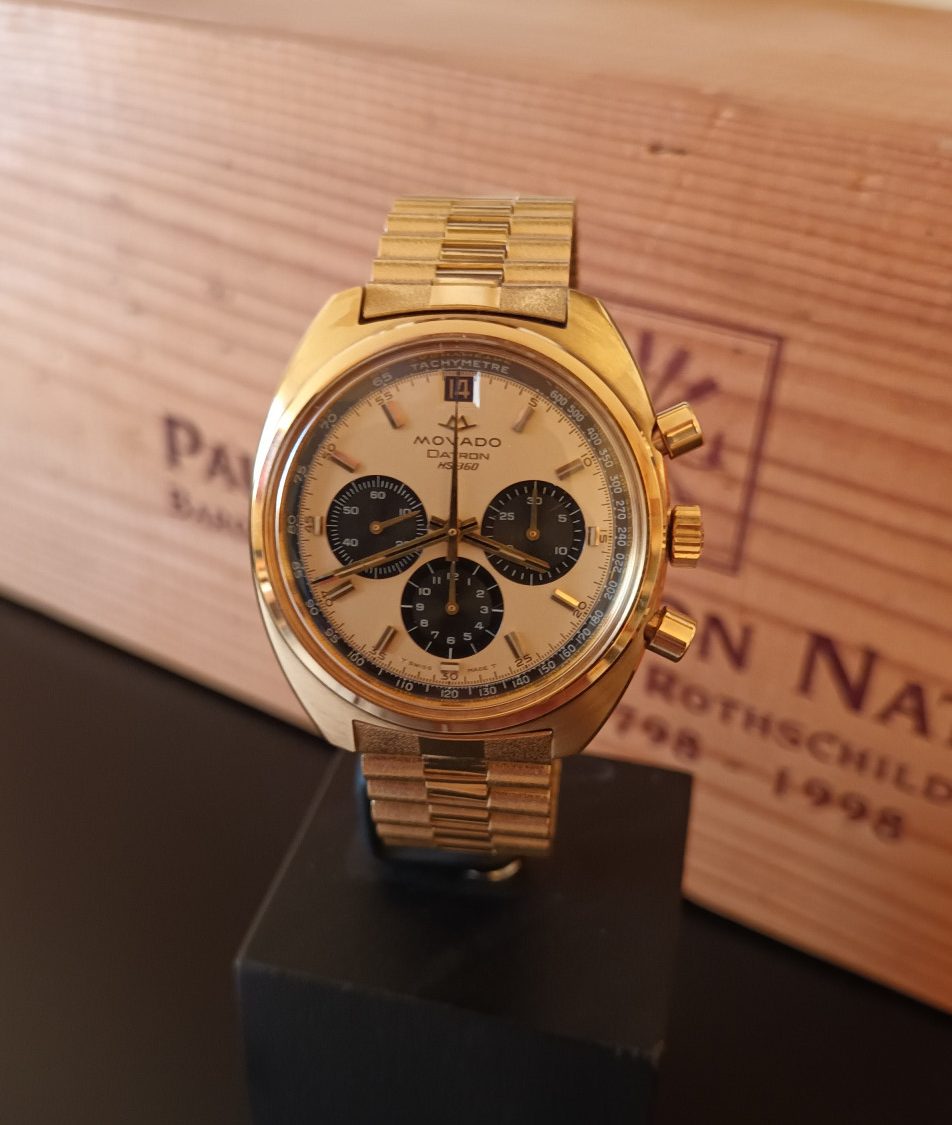
The El Primero movement used here was still designated 3019 PHC, but the minor changes were exclusive to Movado. As it is an integrated chronograph unit (as opposed to modular) it is very slim at only 6.5 mms and beats at 36,000 vph and can record a unique (at the time) 1/10ths of a second. The power reserve is very impressive for the day at some 45- 50 hours (there is a little confusion here. Ed). As already mentioned, jewels are either 17 or 31 depending on the market. (I have not been in the back of mine yet but I assume 31 jewels. Ed).
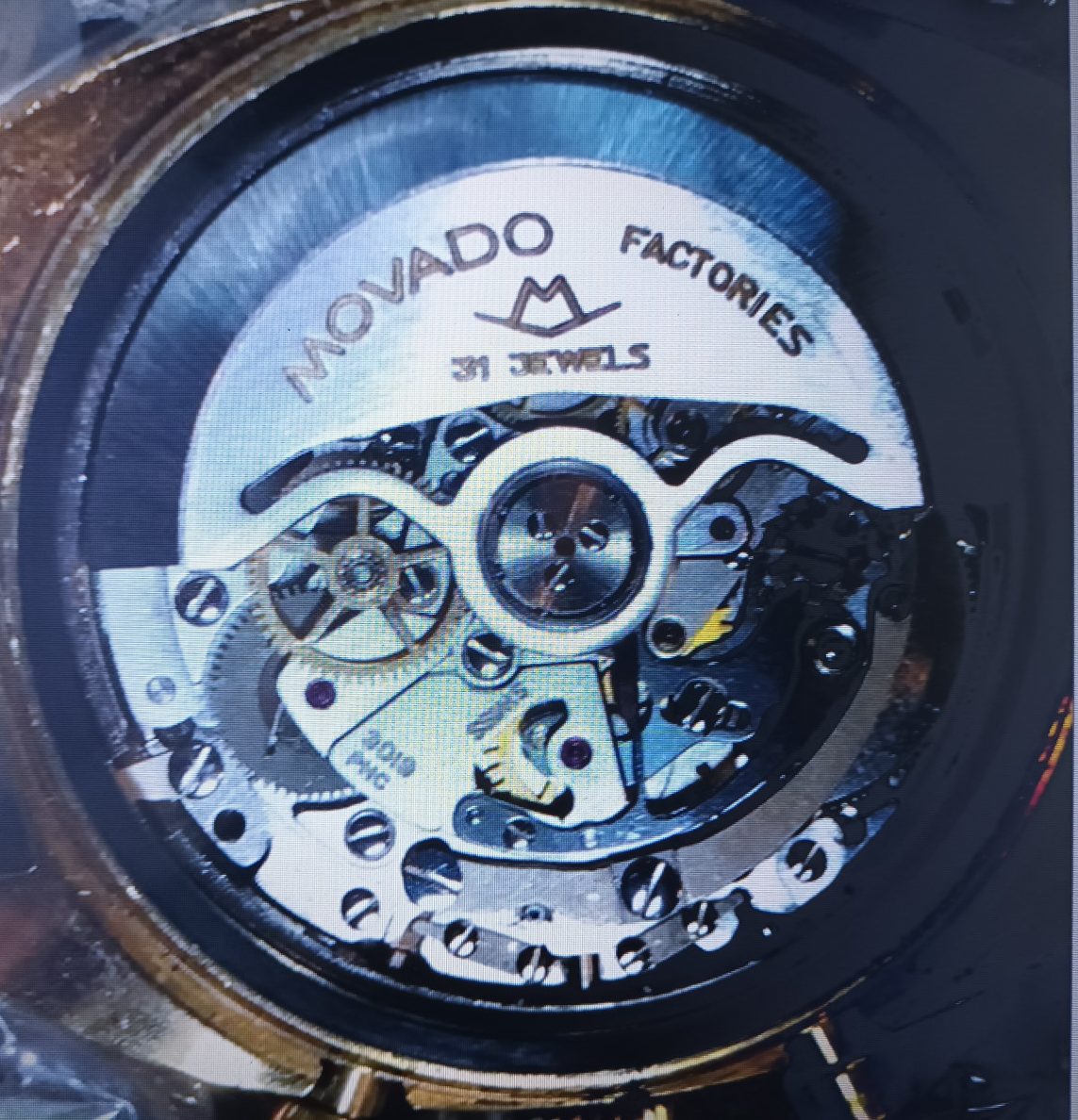
In terms of being famous, well, this Movado is not really – compared to some Zenith versions. It should however not be viewed as inferior as it is just as well made, and the powertrain is basically the same. It did, by the way, make it into space with one Cdr Gerry Carr in Skylab 4, from November 1973 to February 1974!!
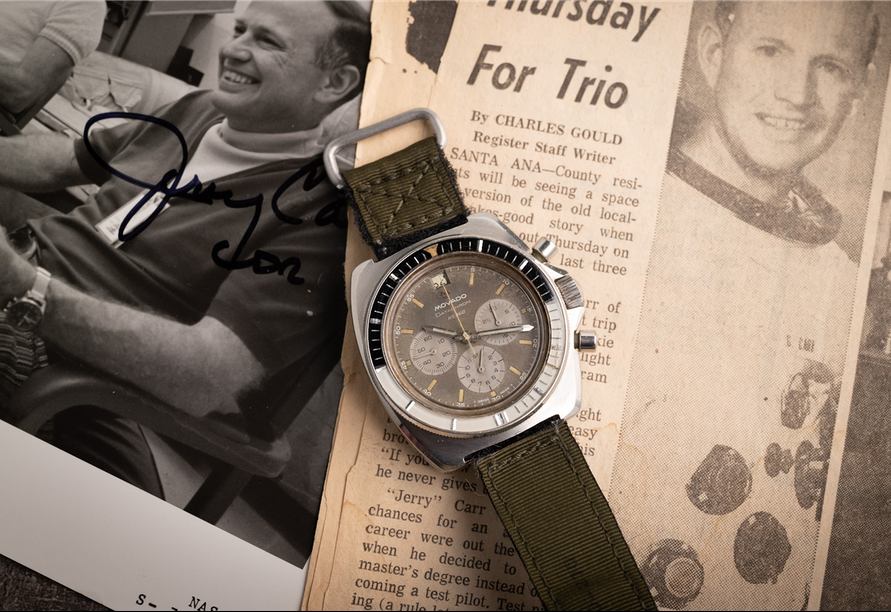
As far as I am concerned, I actually prefer this Movado (ref 434-815-502) as an overall package to contemporary Zeniths, which I find look a bit clunky and not so sophisticated dial-wise. Also, to find one with this dial configuration – along with original bracelet and in this condition, is a bit “hens teeth” and I have yet to find another for sale. I would also go as far as to say that this, for me, is one of the most attractive chronograph ever produced, even edging out my Ebel 1911 and a couple of IWC pilots!! This, plus the mechanical quality and generally lower than Zenith prices, makes it a very compelling and wearable proposition today.
Rating: 5/5 (I rarely rate vintage pieces, but in this case why not!)
Words/Images: The Writer (unless otherwise noted)

